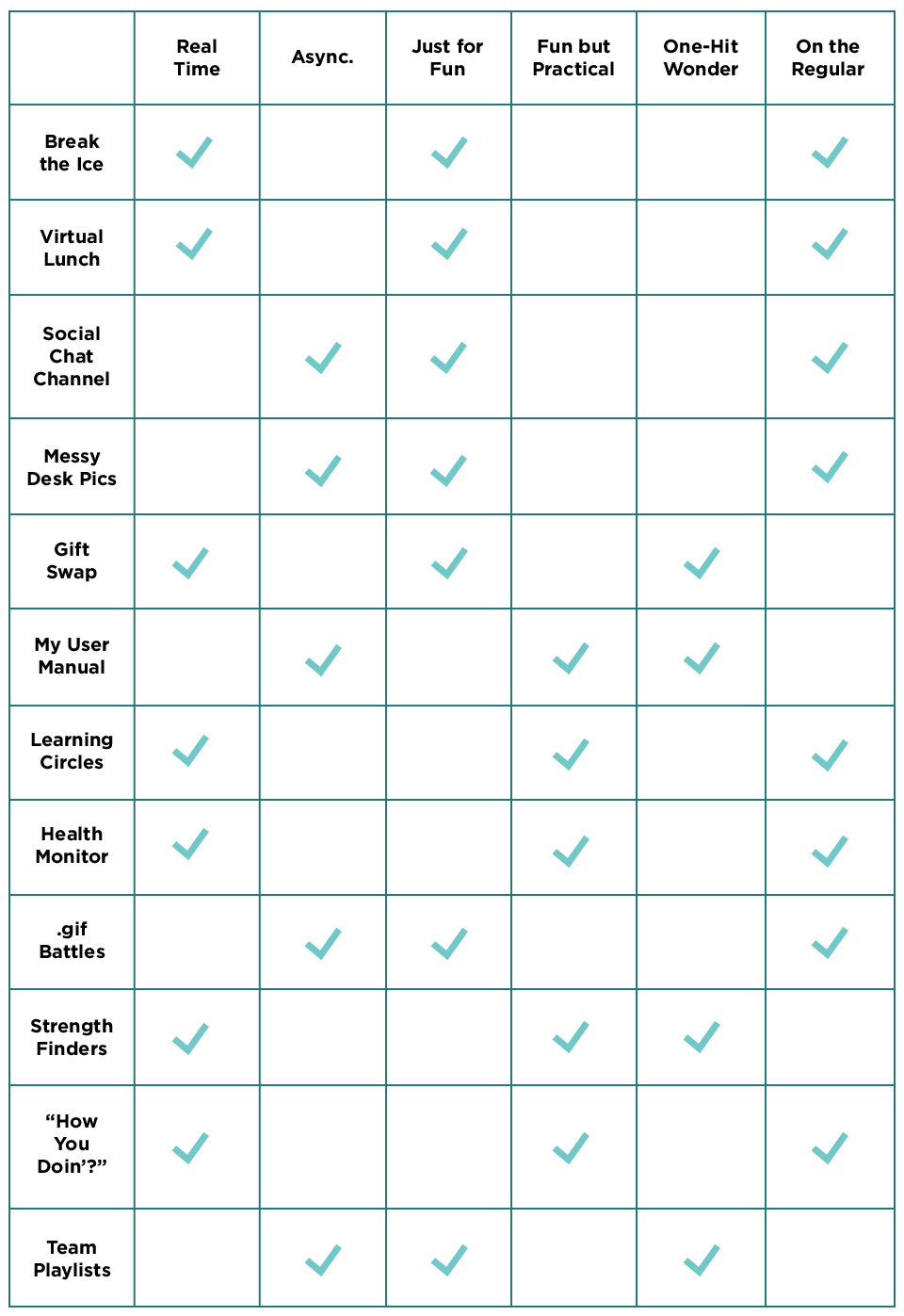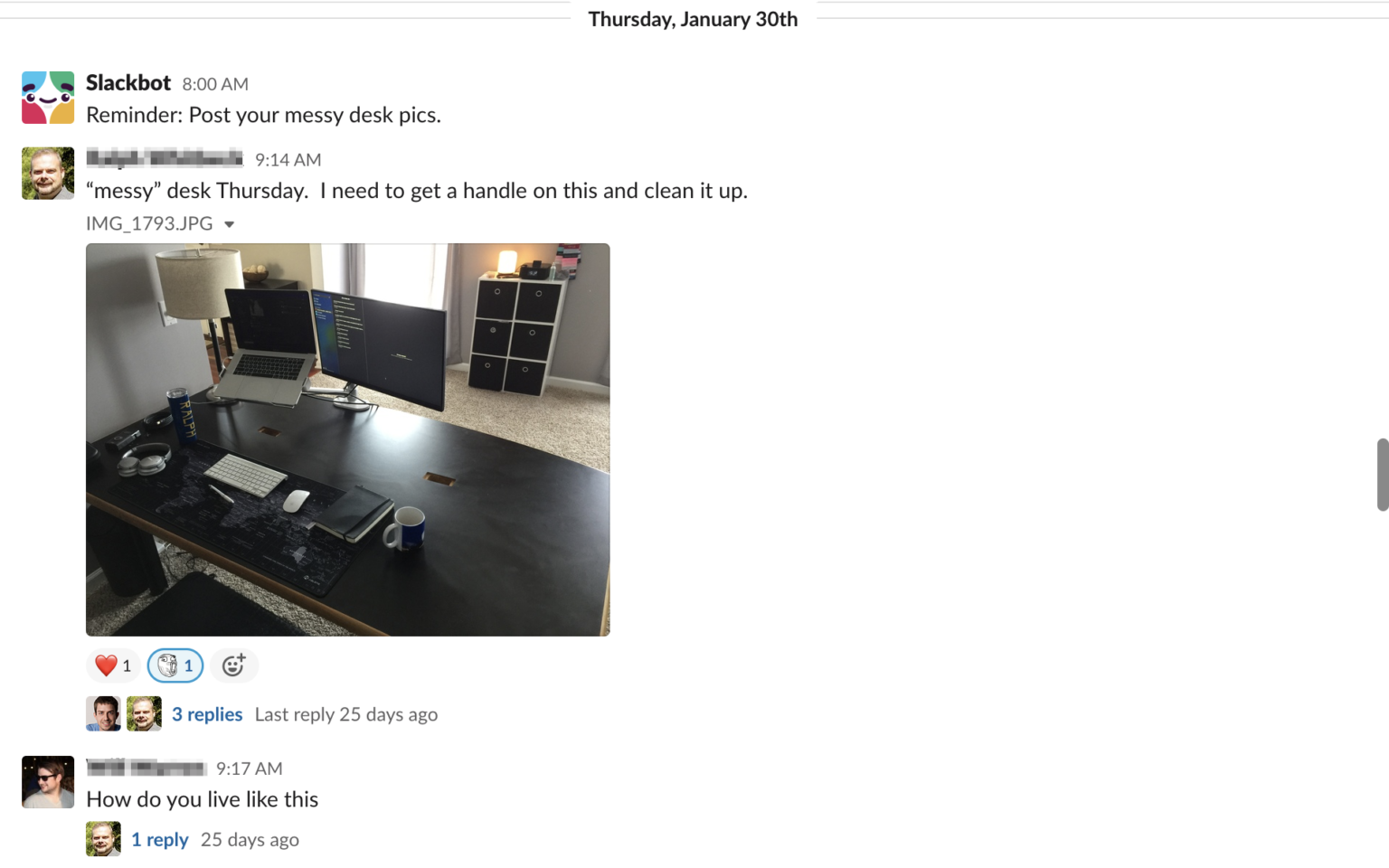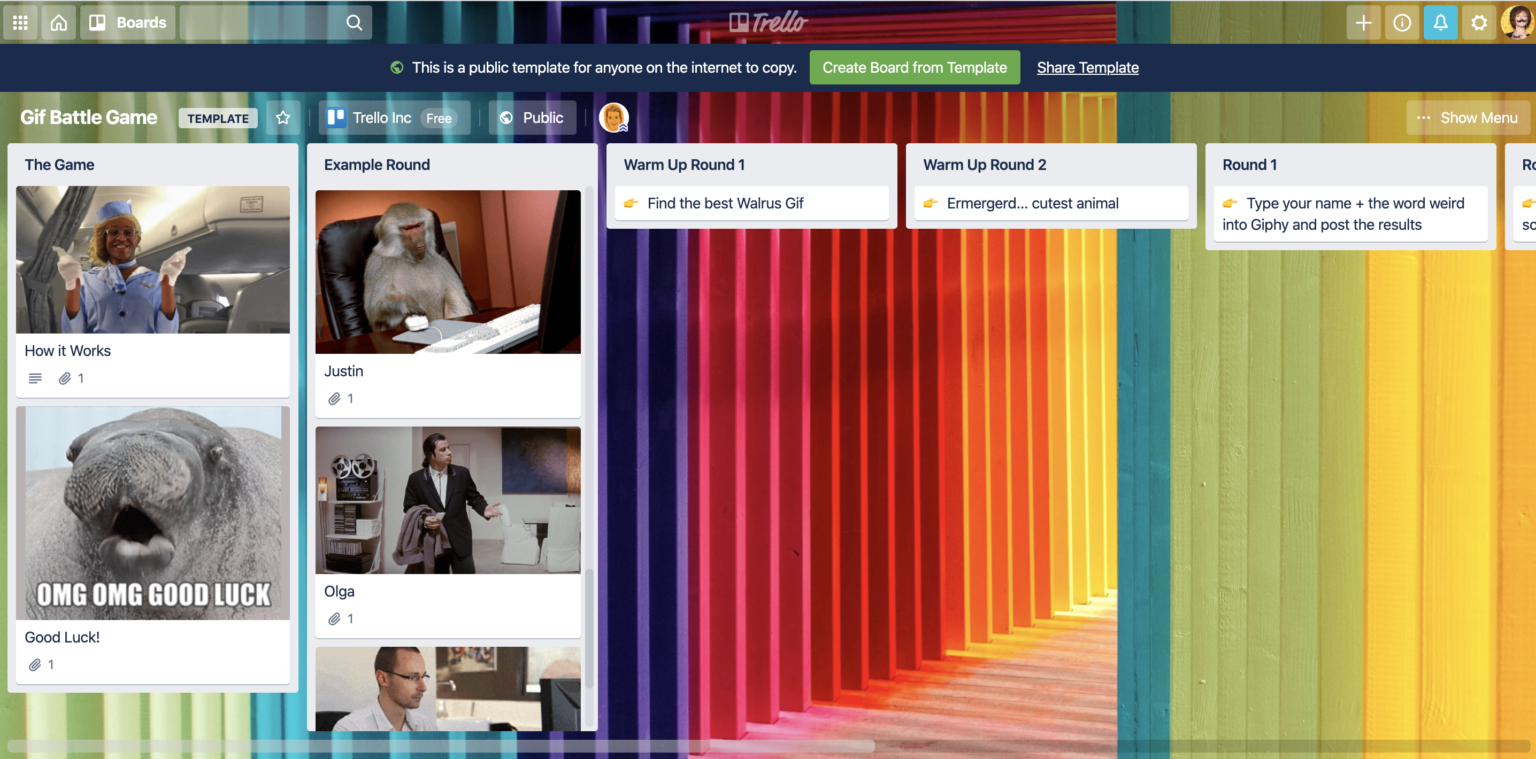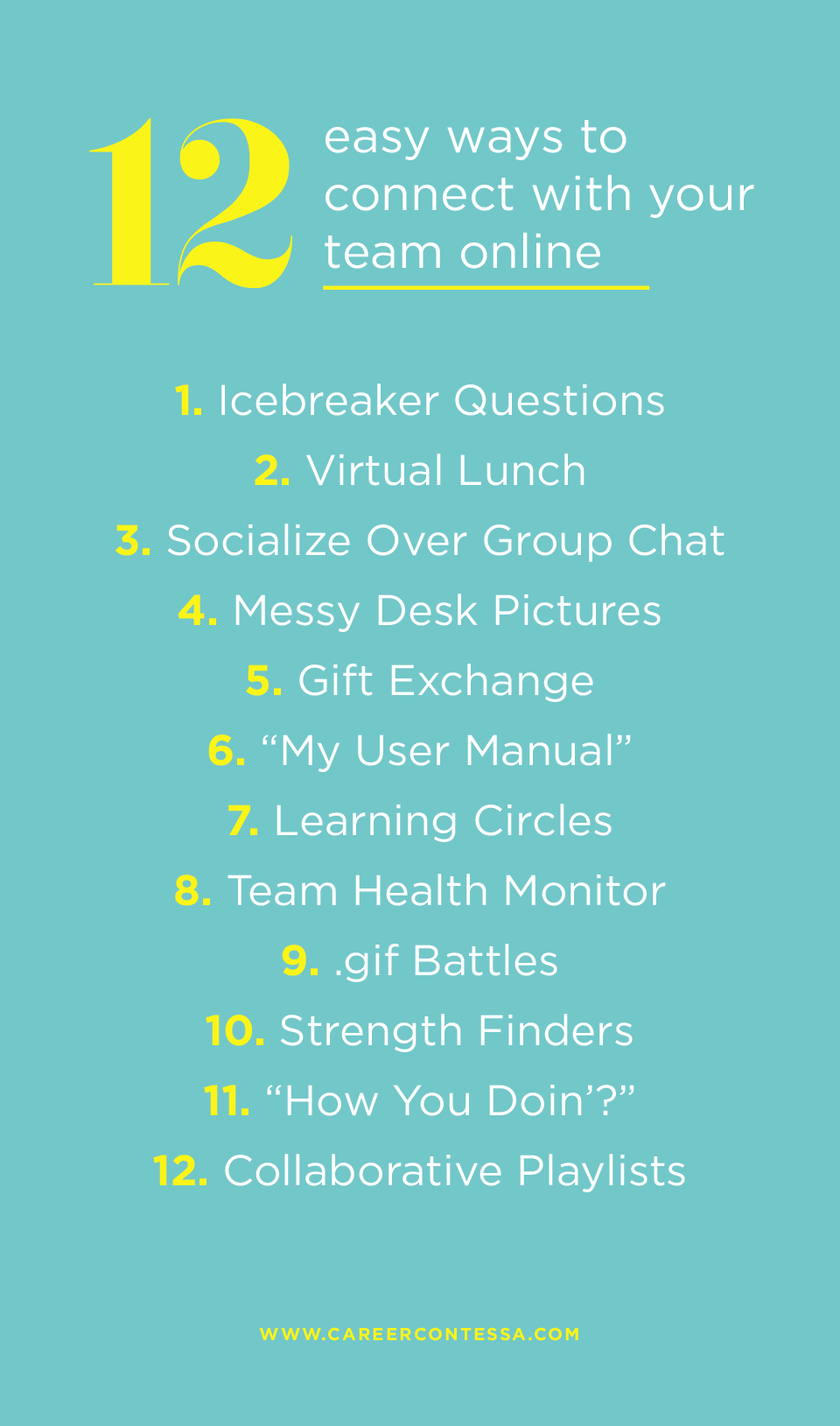What is virtual team building?
We use Trello boards as sort of a virtual whiteboard, Slack as our chat tool, and Zoom for video conferencing. You’ll need at least one of these tools (or their equivalent) for each of the activities shared here.
Why is virtual team building important?
Road-tested team building activities that real-life remote teams actually do

Icebreaker Questions
Time: 5 minutes
Tools required: video conferencing
Before you roll your eyes and go “Duh… like I hadn’t already thought of that”, understand that some of our distributed teams (my own included) do an icebreaker at the start of our team meetings every week. Even though we’ve been working together for a couple of years and feel pretty connected already, there are always more interesting tid-bits to learn about each other. Some recent favorites include:
- Who was the last artist you searched for on your music streaming service of choice?
- What are your parents’ best qualities?
- Put these morning routine items in order: breakfast, coffee/tea, open up your laptop
- What was something that always frightened you as a child?
Virtual Lunch
Time: 60 minutes
Tools required: video conferencing
This one comes from the engineering team that builds the Trello app for Android. Once a month, the team links up via video conferencing over lunchtime. Team members can even expense up to $25 so they can join from their favorite cafe, order delivery, or cook up a little something special at home (because, real talk: heating up leftovers gets old).
Only have 15-30 minutes to spare? No worries. Virtual coffee chats and virtual happy hours are fun variations on this activity.
Socialize Over Group Chat
Time: varies
Tools required: Slack, Teams, or other group chat app
Group chat is an ideal way for distributed teams to stay in touch, but who says you have to keep it strictly business? Atlassian set up a channel in Slack called #social-remote where we remote workers talk about what we had for lunch, compare notes on standing desks, share articles related to remote work, and generally discuss anything but the projects we’re working on. There are even off-shoot channels for cities or states where clusters of “Remote-lassians” live. Let’s just say that more than a few hot-dish recipes have been swapped in the #minnesota channel.
Messy Desk Pictures
Time: 5 minutes
Tools required: Slack, Teams, or other group chat app
When you work in an office, you feel compelled to keep your desk at least minimally clean: no used tissues, 3-day old cereal bowls, or constellations of coffee rings. But when you work from home, there’s no such social contract to uphold. So one of our rituals in the #social-remote Slack channel is “messy desk Thursdays” in which we out ourselves for the abysmal state of our workstations while the ROTFL ??and ?????? facepalm emojis fly fast and thick.
It’s also a chance for your preternaturally tidy teammates to do some humble bragging about their austere, magazine-worthy office spaces.

Gift Exchange
Time: 60 minutes
Tools required: video conferencing, Trello board
Whether your team prefers white elephant style or something more thoughtful, you can pull off a gift exchange even if you’re not at an offsite. Start by copying this handy Trello board template and inviting your teammates to join. It has full instructions in the “Rules” column, but here’s the gist. Each team member buys a gift that can be shipped easily. Instead of announcing what the gift is, you’ll add a card to the board with a picture and title that provides a hint.
During the game, you’ll take turns clicking on cards to reveal what the gift is. (In the example below, “Something for the epicurean” turned out to be a cookbook and some fancy olive oil.) Once you turn over a card, you’ve claimed that gift. You’ll also get chances to steal a gift someone else has already claimed. After the game is over, mail the gift you contributed to the person who ended up with it.
“My User Manual”
Time: 60 minutes
Tools required: Keynote or PowerPoint
When you’re just forming as a team, or when a new member joins, it’s worth taking the time to share your personal workstyle. Do you prefer chat or email? What time of day do you do your best heads-down deep work? Are you cool with impromptu video calls? Check out this example from the CEO at CultureAmp:
Learning Circles
Time: 30-60 minutes
Tools required: video conferencing, study materials as needed
It’s easy to get so caught up in executing on your work that you forget to expand your horizons, especially when working from home with no office banter happening around you. Plus, remote work can be isolating if you don’t make a point to connect with your teammates on a personal level. Learning circles address both issues. Choose a topic related to your work that you want to learn more about – anything from SQL to leadership styles to trends in recruiting practices – and find colleagues who share that interest. Each month, gather over video conference to discuss a book or article, or have someone in the group give a short presentation. (Find detailed instructions, tips, and templates for learning circles here.) The best part about learning circles is that you can extend them beyond your immediate team and connect with people across the entire organization.
Team Health Monitor
Time: 30-60 minutes
Tools required: video conferencing, Confluence or Google Docs
This variation on the classic agile retrospective prompts you to examine how you’re working together, instead of what you’re working on. Through extensive research, we identified eight attributes that healthy, high-performing teams tend to have in common, then developed the health monitor as a framework for assessing how your team is doing in each area. Do you have the right balance of skills on the team? Are you making decisions effectively? Do you understand the dependencies around your work? Here’s a one-minute overview, staring yours truly.
.gif Battles
Time: 15-30 min
Tools required: video conferencing, Trello board
If you’ve ever been jealous of the Nerf dart wars waged by your co-located colleagues and friends, you’ll love .gif battles. Copy this Trello board template and invite your teammates to join it. (Click on the “How it works” card to see full instructions for the game.) The game consists of four rounds, each with its own theme. You’ll use Giphy.com or Google Images to find a .gif that fits with the theme for that round and attach that gif to a card. Once everyone has their gifs in, you’ll vote on the round’s best submission. At the end, the person who wins the most rounds will be crowned the Ultimate Gif Battle Champion of All Time™. Just think of the glory! Don’t be afraid to add a tiebreaker round if needed.

Strength Finders
Time: 30 min individual prep, 60 min as a team
Tools required: video conferencing
If you’re ready to go beyond surface-level connections with your team, this is the activity for you. Each person will prepare for the session by taking an online strength finder assessment such as Clifton Strengths ($49 per person). During the group session, everyone hops on a video call and takes turns sharing their results. When my team did this, each person shared top three strengths, lowest-ranked strength, and something in our results that surprised us. Then we’d discuss as a group how that person’s top strengths contribute to the team already, and how we could make even better use of them.
This is an intensely personal activity. You’re going to feel a bit vulnerable and exposed, so it works best if there’s already a sense of psychological safety amongst teammates. But because you’re discussing each other’s strengths, the conversation tends to be very positive and affirming. Chances are, everyone will walk away with a deeper sense of belonging and an understanding of the unique value they bring to the team.
“How You Doin’?”
Time: 5 min
Tools required: video conferencing, Trello board
(This one is so much better if you say the words “How you doin’?” in a low, Jersey mobster voice – think Sal from “The Sopranos”. But I digress…) The team that looks after the Atlassian Community website and our user groups added this five-minute ritual to the beginning of their weekly team meetings. The board they use to track agenda items includes a space for each person to add a card representing how they’re feeling that week. Maybe they’re struggling with something in their personal life and are a bit low-energy. Maybe they finally ran that 10k over the weekend and are PUMPED for the week ahead. It’s an easy way for teammates to let each other know when they might need some extra support or patience, or when they’ve got good vibes to spare.
Collaborative Playlists
Time: varies
Tools required: Spotify or Google Play, Slack or other group chat app
Raise your hand if you and your remote teammates talk about music. (Thought so. Pretty much everyone does.) The content team at Trello is no different… but they’ve gone next-level with it. Using Spotify, they create collaborative playlists that anyone on the team can listen to and help curate. Try creating an upbeat, “get $#!t done” playlist, a soothing “de-stress” playlist, or any other theme that suits your team.












